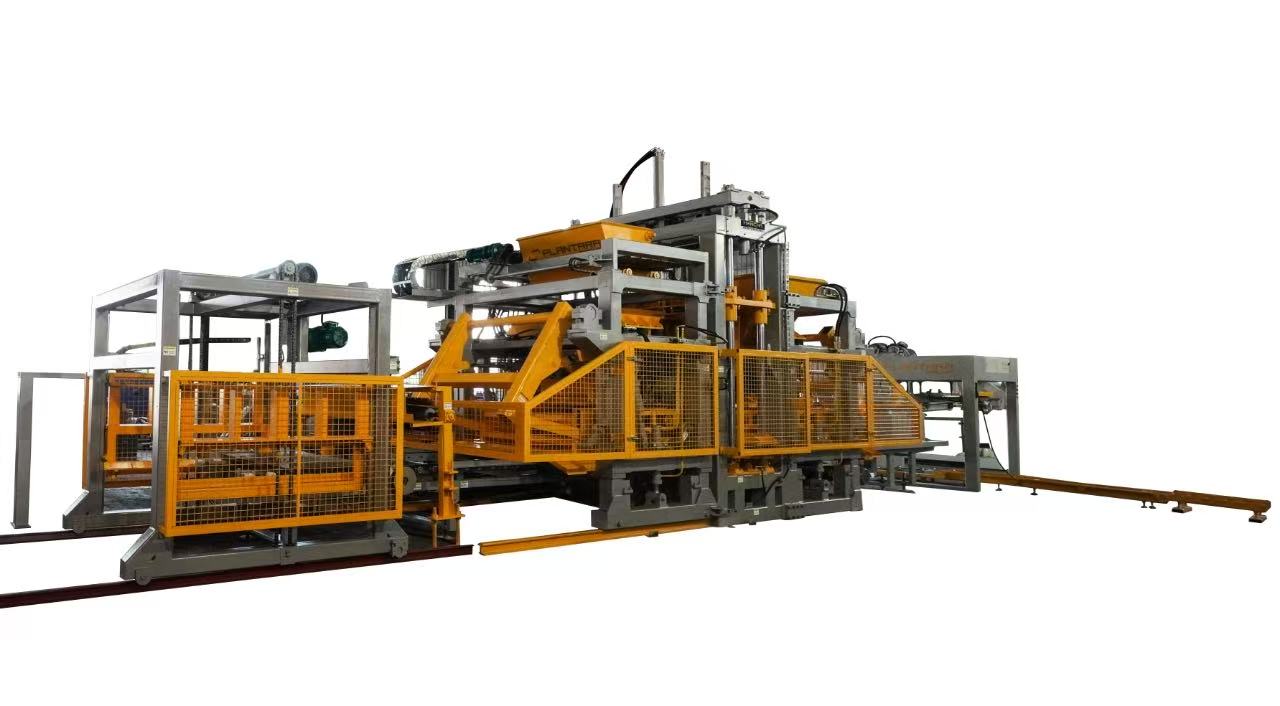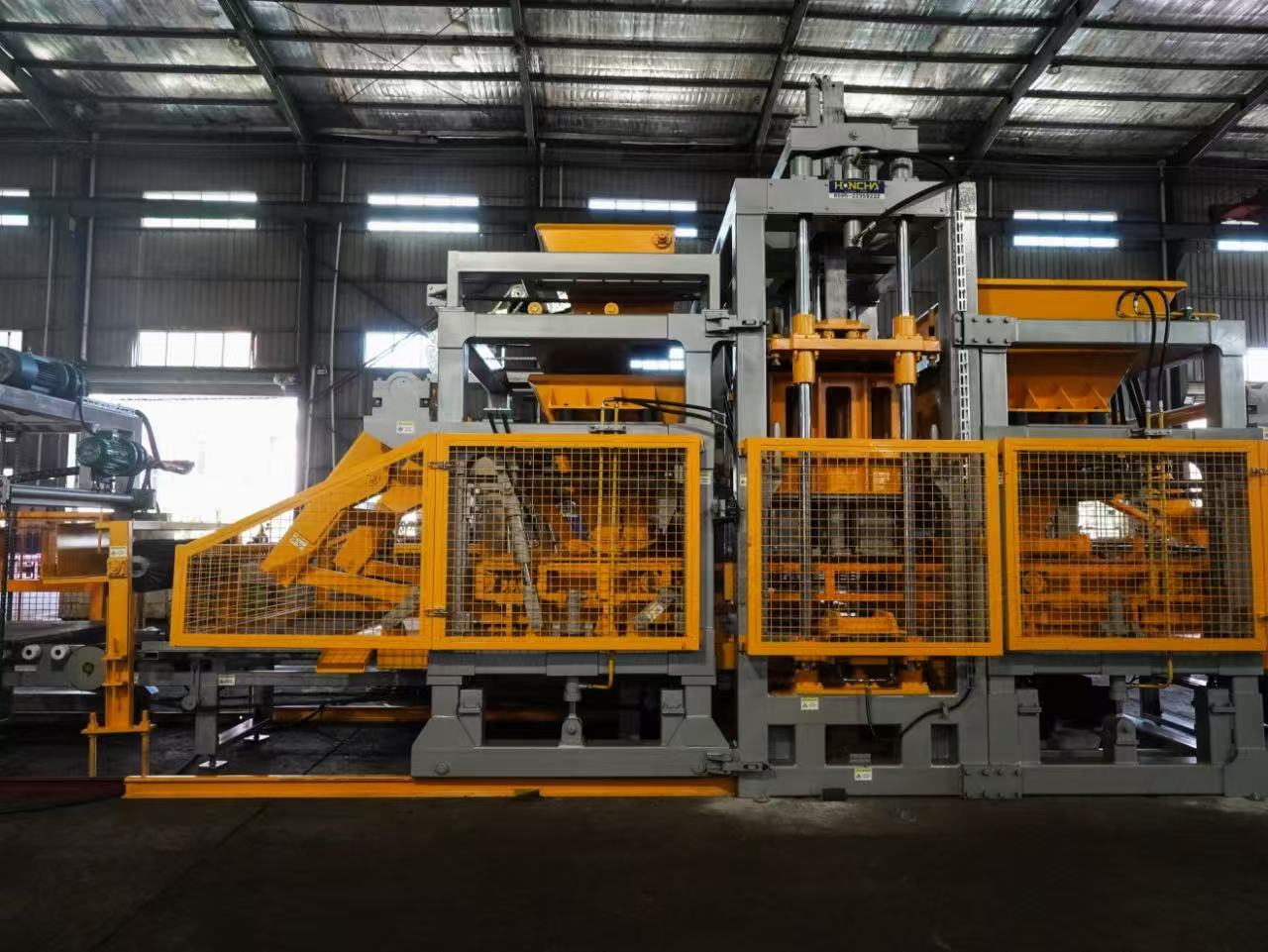This is a fully automatic block forming machine, which is often used in the field of building material production and can produce a variety of block products. The following is an introduction from aspects such as the product principle, producible products, advantages, and application scenarios:
I. Working Principle
The fully automatic block forming machine mixes raw materials (such as cement, sand and gravel, fly ash, etc.) in a certain proportion, then sends them into the mold cavity of the main machine. Through processes such as high-pressure vibration and pressing, the raw materials are formed in the mold, and then various block products are obtained after demolding. The whole process is precisely controlled by the PLC control system to realize the automatic operation of links such as feeding, mixing, forming, demolding, and conveying.
II. Types of Producible Products
1. Ordinary concrete blocks: Using cement, aggregates, etc. as raw materials, solid and hollow blocks of different specifications can be produced, which are used for the masonry of general building walls, such as the non-load-bearing walls of residences and factories. They have a certain degree of strength and durability and can meet the needs of basic building structures.
2. Permeable bricks: The special raw material formula and mold design make the formed permeable bricks have rich connected pores. When paved on roads, squares, etc., they can quickly infiltrate rainwater, supplement groundwater resources, alleviate urban waterlogging, and also reduce the heat island effect and improve the urban ecological environment.
3. Slope protection bricks: They have unique shapes (such as interlocking type, hexagonal type, etc.). When paved on river courses, slopes, etc., they interlock with each other to enhance stability, resist water erosion and soil landslides. At the same time, they are conducive to vegetation growth and realize ecological slope protection. They are widely used in slope protection projects of water conservancy, transportation and other projects.
4. Pavement bricks: Including colored pavement bricks, anti-skid pavement bricks, etc., they are used for paving urban sidewalks, park paths, etc. Through different molds and raw material proportions, they can present various colors and textures, and have both decorative and practical properties. They are wear-resistant and anti-skid, and can adapt to the loads of pedestrians and light vehicles.
III. Equipment Advantages
1. High degree of automation: From raw material transportation to finished product output, the whole process runs automatically, reducing manual intervention, lowering labor intensity, and improving production efficiency. It can operate continuously for 24 hours and is suitable for large-scale block production.
2. Good product quality: The high-pressure vibration and pressing process make the blocks have high compactness, uniform strength, precise dimensions and regular appearance, which can effectively ensure the quality of building construction, reduce problems such as wall cracks, and improve the overall quality of buildings.
3. Energy conservation and environmental protection: It can use industrial waste residues such as fly ash and slag as raw materials to realize resource recycling and reduce dependence on natural sand and gravel; at the same time, the advanced control system optimizes energy consumption. Compared with traditional equipment, it has more advantages in electricity and raw material consumption, conforming to the concept of green building material production.
4. Flexibility and diversity: By changing the molds, it can quickly switch to produce block products of different types and specifications, meeting the diversified market demands. Enterprises can flexibly adjust production according to orders and enhance market adaptability.
IV. Application Scenarios
It is widely used in scenarios such as building material production enterprises, the production of supporting blocks for construction projects, and municipal engineering construction. In building material factories, various blocks are produced in batches to supply the market; at the construction project sites, suitable blocks can be produced on demand, reducing transportation costs and losses; in municipal road, park, water conservancy and other projects, this equipment is also often equipped to produce exclusive blocks, ensuring the progress and quality of projects, promoting the efficient and green development of the construction and municipal industries, and providing diversified and high-quality building material products for urban construction.
This is a fully automatic block forming machine, which plays a crucial role in the production of building materials. The following is an introduction from multiple aspects:
I. Working Process
First, raw materials such as cement, sand and gravel, and fly ash are mixed in proportion. Then, they are sent into the mold cavity of the main machine. Through high-pressure vibration and pressing, the raw materials are formed in the mold. Finally, after demolding, various block products are produced. The entire process is controlled by a PLC control system, and links such as feeding, mixing, and forming are completed automatically, which is efficient and precise.
II. Producible Products
1. Ordinary concrete blocks: Using cement and aggregates as raw materials, solid and hollow blocks of different specifications can be produced. They are used for the masonry of non-load-bearing walls of residences and factories. They have a certain degree of strength and durability and can meet the needs of basic building structures.
2. Permeable bricks: With a special raw material formula and mold, the brick body has abundant connected pores. When paved on roads and squares, they can quickly infiltrate rainwater, supplement groundwater, alleviate waterlogging, and also reduce the heat island effect and improve the urban ecology.
3. Slope protection bricks: They have unique shapes such as interlocking type and hexagonal type. When paved on river courses and slopes, they interlock with each other to enhance stability, resist water erosion and soil landslides, and are conducive to vegetation growth, realizing ecological slope protection. They are commonly used in slope protection projects of water conservancy and transportation.
4. Pavement bricks: Including types such as colored and anti-skid ones, they are used for sidewalks and park paths. Through different molds and raw material proportions, various colors and textures are presented. They are wear-resistant and anti-skid, suitable for the loads of pedestrians and light vehicles, and have both decorative and practical properties.
III. Equipment Advantages
It has a high degree of automation. The whole process from raw materials to finished products is automatic, reducing manual work, lowering labor intensity, and improving efficiency. It can operate 24 hours a day and is suitable for large-scale production. The quality of the products is good. The high-pressure process makes the blocks have high compactness, uniform strength, precise dimensions, and regular appearance, ensuring the quality of building construction. It is also energy-saving and environmentally friendly. It can use industrial waste residues as raw materials, recycle resources, and reduce dependence on natural sand and gravel. The advanced control system optimizes energy consumption, conforming to the concept of green production. Moreover, it is flexible and diverse. By changing the molds, block products of different types and specifications can be produced. Enterprises can adjust according to orders and enhance market adaptability.
Post time: Jul-19-2025

 +86-13599204288
+86-13599204288

